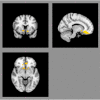Marijuana craving in the brain
- PMID: 19651613
- PMCID: PMC2716383
- DOI: 10.1073/pnas.0903863106
Marijuana craving in the brain
Abstract
Craving is one of the primary behavioral components of drug addiction, and cue-elicited craving is an especially powerful form of this construct. While cue-elicited craving and its underlying neurobiological mechanisms have been extensively studied with respect to alcohol and other drugs of abuse, the same cannot be said for marijuana. Cue-elicited craving for other drugs of abuse is associated with increased activity in a number of brain areas, particularly the reward pathway. This study used functional magnetic resonance imaging (fMRI) to examine cue-elicited craving for marijuana. Thirty-eight regular marijuana users abstained from use for 72 h and were presented with tactile marijuana-related and neutral cues while undergoing a fMRI scan. Several structures in the reward pathway, including the ventral tegmental area, thalamus, anterior cingulate, insula, and amygdala, demonstrated greater blood oxygen level dependent (BOLD) activation in response to the marijuana cue as compared with the neutral cue. These regions underlie motivated behavior and the attribution of incentive salience. Activation of the orbitofrontal cortex and nucleus accumbens was also positively correlated with problems related to marijuana use, such that greater BOLD activation was associated with greater number of items on a marijuana problem scale. Thus, cue-elicited craving for marijuana activates the reward neurocircuitry associated with the neuropathology of addiction, and the magnitude of activation of these structures is associated with severity of cannabis-related problems. These findings may inform the development of treatment strategies for cannabis dependence.
Conflict of interest statement
The authors declare no conflict of interest.
Figures



References
-
- Wong DF, et al. Increased occupancy of dopamine receptors in human striatum during cue-elicited cocaine craving. Neuropsychopharmacology. 2006;31:2716–2727. - PubMed
-
- McClernon FJ, Hutchison KE, Rose JE, Kozink RV. DRD4 VNTR polymorphism is associated with transient fMRI-BOLD responses to smoking cues. Psychopharmacology (Berl) 2007;194:433–441. - PubMed
-
- Wexler BE, et al. Functional magnetic resonance imaging of cocaine craving. Am J Psychiatry. 2001;158:86–95. - PubMed
Publication types
MeSH terms
Substances
Grants and funding
LinkOut - more resources
Full Text Sources
Medical

